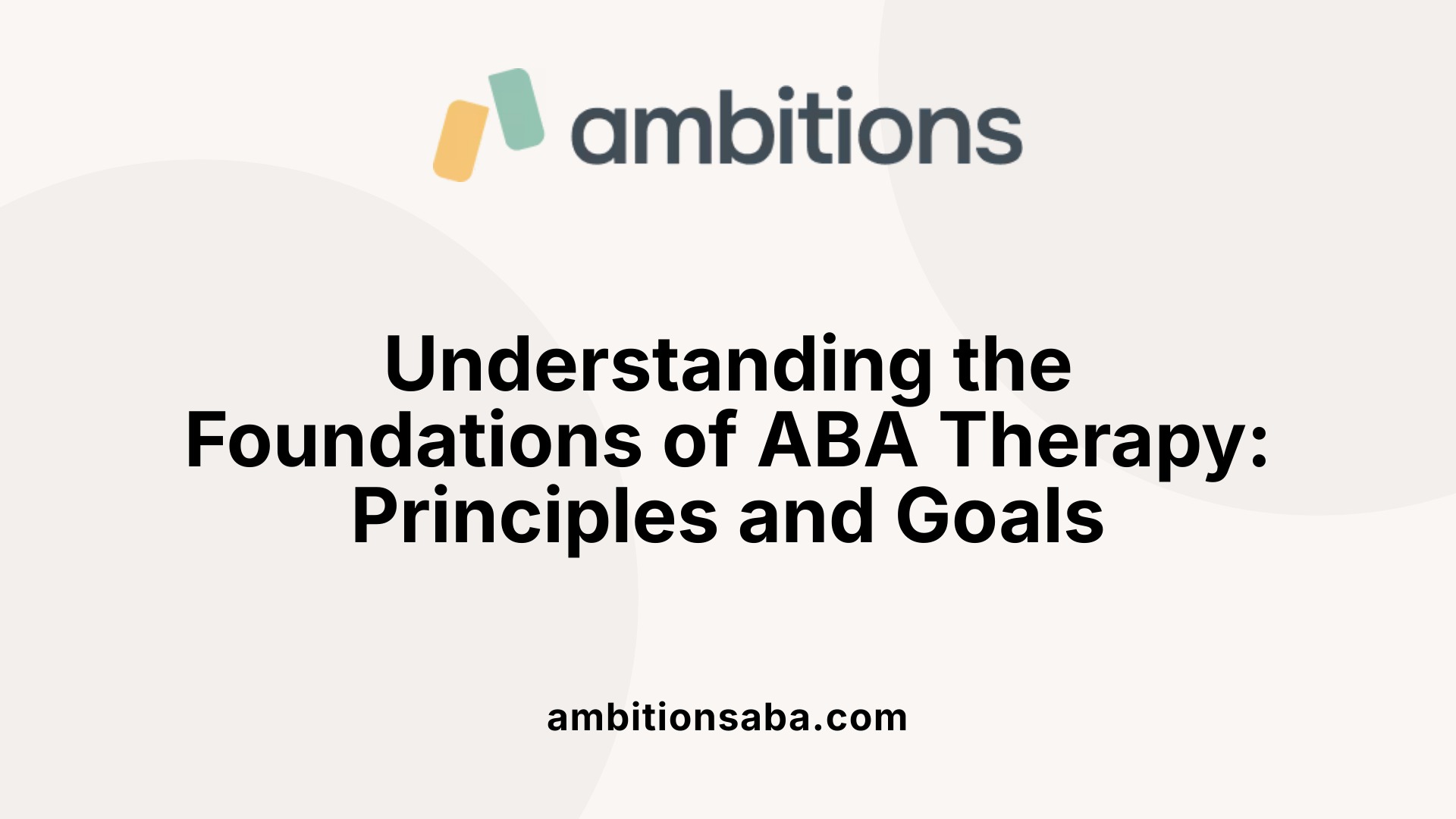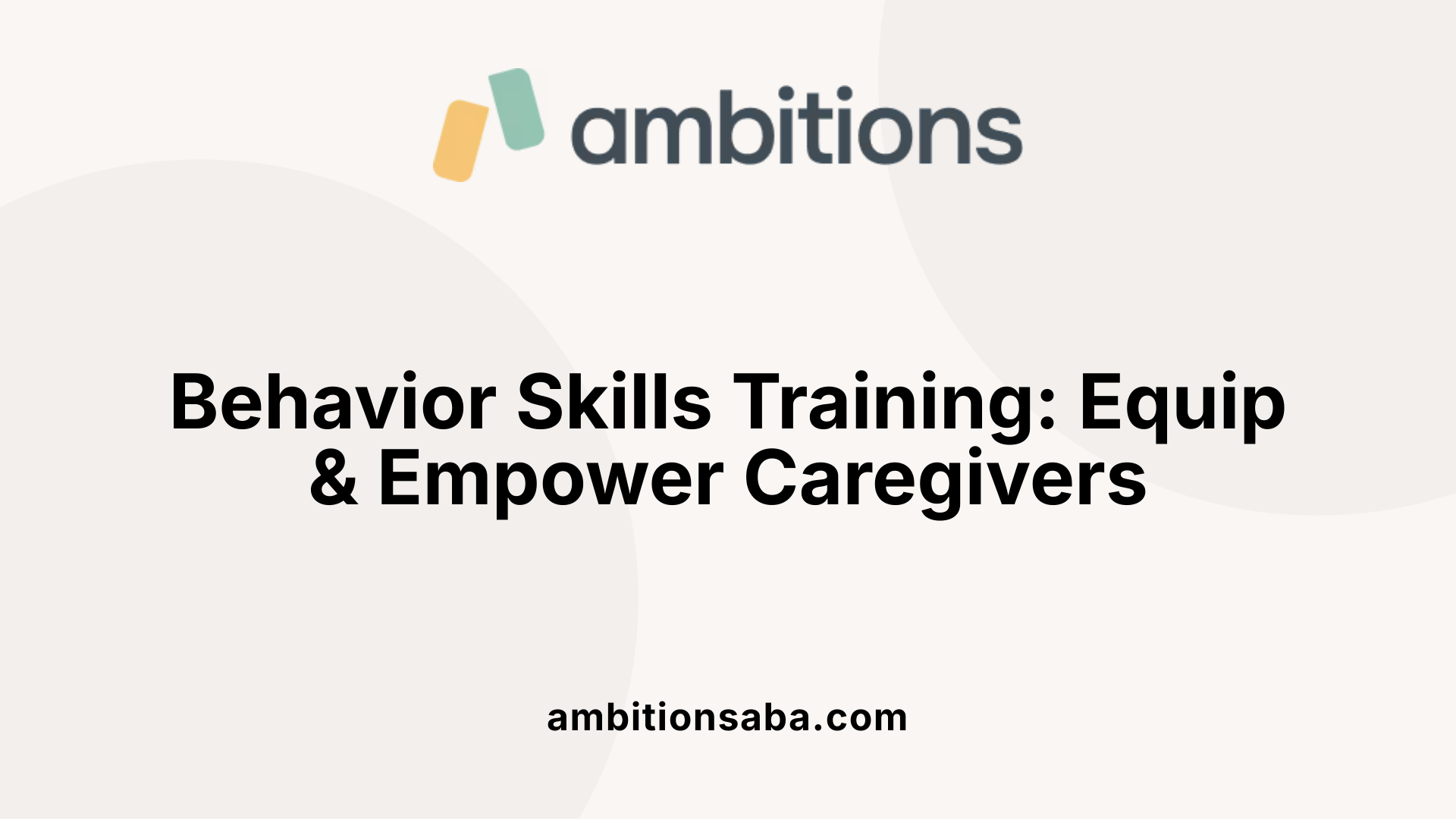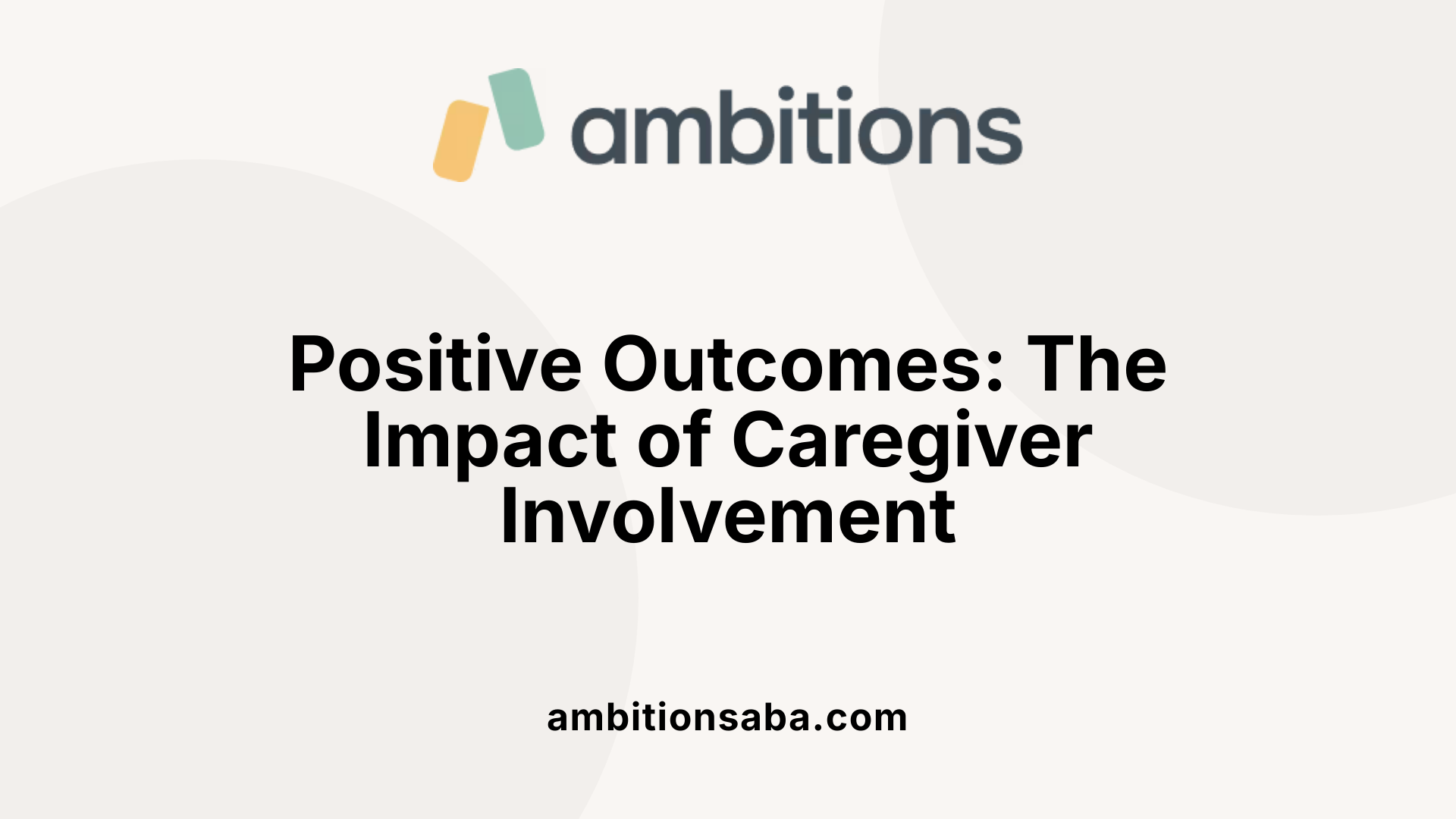Understanding the Role of Caregivers in ABA Therapy
Applied Behavior Analysis (ABA) therapy is widely recognized as an effective evidence-based approach to supporting individuals with autism. While much focus is placed on the work of certified professionals, the involvement and training of caregivers are equally crucial. Behavior skills training equips caregivers with practical tools and knowledge to reinforce positive behaviors and promote developmental progress in everyday environments, enhancing the overall impact of therapy.
What is Applied Behavior Analysis (ABA) Therapy and Its Core Principles?

Definition of ABA Therapy
Applied Behavior Analysis (ABA) therapy is a science-based approach focused on understanding behavior and how it is influenced by environmental factors. It helps explain how learning occurs and uses this understanding to support individuals, especially those with autism, by enhancing beneficial behaviors and reducing disruptive ones.
The Science Behind ABA
ABA relies on analyzing the ABCs of behavior: antecedents (what happens before a behavior), behaviors themselves, and consequences (what follows the behavior). This systematic examination helps therapists identify patterns and modify behaviors effectively.
Goals of ABA Therapy
The main objectives of ABA are to increase helpful behaviors such as communication, social skills, attention, and academic abilities while decreasing harmful or disruptive behaviors. This dual focus aims to improve overall independence and quality of life for the individual.
ABA’s Adaptable Nature
ABA programs are customized based on thorough assessments by certified behavior analysts (BCBAs). Therapy plans are dynamic and adjusted continually based on data gathered from ongoing evaluations. ABA can be delivered in homes, schools, or community settings, using one-on-one or group formats to best fit each individual's needs.
Positive Reinforcement
Positive reinforcement is a cornerstone of ABA; desirable behaviors are encouraged using rewards that are meaningful to the person receiving therapy. This approach increases the likelihood that these helpful behaviors will continue in the future.
Supporting Individuals with Autism
ABA therapy supports individuals with autism by applying these principles to teach essential skills, reduce problem behaviors, and promote independence. It is an evidence-based treatment recognized by authorities like the US Surgeon General and the American Psychological Association, backed by extensive research demonstrating its effectiveness.
By combining scientific methods with individualized care, ABA provides structured and effective support aimed at fostering meaningful progress for those receiving treatment.
The Critical Role of Caregivers in ABA Therapy Success

Why Is Caregiver Involvement Important in ABA Therapy?
Caregivers play a crucial role in the success of Applied Behavior Analysis (ABA) therapy. Their involvement ensures that skills taught during therapy sessions are reinforced consistently across different environments and daily routines. When caregivers are active participants, they provide the continuous encouragement and support that help maintain and generalize the new behaviors learned.
How Do Caregivers Support Skill Acquisition?
Caregivers help facilitate skill learning by practicing techniques recommended by therapists. They often engage in structured activities at home or in community settings, providing real-life opportunities for the child to develop language, social, and communication skills. This hands-on support enhances the learning process and accelerates progress.
What Is the Generalization of Skills and How Do Caregivers Help?
Generalization refers to the ability to apply newly learned skills in various settings outside therapy sessions. Caregivers encourage this by reinforcing behavior in different contexts such as home, school, or social environments. Their involvement is essential to help skills become functional and meaningful in everyday life.
Can Caregivers Act as Therapeutic Agents?
Yes, caregivers often serve as therapeutic agents by delivering ABA strategies consistently throughout the day. With proper training and guidance from a Board Certified Behavior Analyst (BCBA), they can implement behavior reinforcement techniques safely and effectively, making therapy more comprehensive and integrated.
What Does a Family-Centered Approach Entail in ABA?
ABA therapy recognizes the family as central to the child’s progress. A family-centered approach involves caregivers in goal-setting, program development, and ongoing evaluation. This collaboration ensures that interventions align with family values and routines, making therapy more personalized and sustainable.
Behavior Skills Training: Equipping Caregivers to Reinforce Positive Behaviors

What is Behavior Skills Training?
Behavior Skills Training (BST) is an essential teaching method used in Applied Behavior Analysis (ABA) therapy to equip caregivers with the tools needed to support and reinforce positive behaviors. BST breaks down complex skills into clear steps, making it easier for caregivers to understand and apply ABA strategies effectively.
What are the Components of Behavior Skills Training?
BST typically involves four core components:
- Instruction: Clear verbal explanations of the skill or procedure to be learned.
- Modeling: Demonstrations of the exact behavior or skill performed by the trainer.
- Rehearsal: Caregivers practice the skill themselves to build confidence and competence.
- Feedback: Constructive critique and coaching to refine the caregiver’s technique.
How Do Modeling and Rehearsal Work?
Modeling serves as a live example of the expected behaviors, allowing caregivers to see precisely how to implement strategies such as positive reinforcement or behavior prompting. Rehearsal gives caregivers hands-on experience in a safe, supportive setting, where they can ask questions and overcome challenges before applying methods in real-life situations.
What Role Does Feedback and Coaching Play?
Ongoing feedback is crucial in BST, providing caregivers with personalized guidance that helps correct mistakes and strengthen their skills. Coaches, often certified behavior analysts or registered behavior technicians, offer encouragement and practical tips tailored to the caregiver’s unique circumstances.
How Are Caregivers Involved in Implementing ABA Strategies?
BST empowers caregivers to become active participants in therapy by teaching them how to identify antecedents and consequences—the ABCs of behavior—and how to use positive reinforcement effectively. This involvement promotes consistency in treatment across home, school, and community settings, which is vital for meaningful progress.
Through Behavior Skills Training, caregivers gain confidence and proficiency, creating a supportive environment that fosters the learner's development and enhances the overall success of ABA therapy.
Professional Qualifications and Their Role in Guiding Caregiver Training

Who typically provides ABA therapy and what qualifications do these professionals have?
ABA therapy is delivered by a specialized team, primarily including Board Certified Behavior Analysts (BCBAs), Board Certified Assistant Behavior Analysts (BCaBAs), and Registered Behavior Technicians (RBTs).
BCBAs are highly qualified professionals who have earned master's or doctoral degrees in behavioral science. They possess certification from the Behavior Analyst Certification Board, which signifies their expertise in designing, supervising, and evaluating individualized ABA treatment plans. Their role is critical in conducting detailed behavioral assessments and ensuring therapy effectiveness.
BCaBAs function to support BCBAs by providing direct services and helping with data collection and analysis. While they also hold certification from the Behavior Analyst Certification Board, their scope is more limited than that of BCBAs.
RBTs are trained technicians who work hands-on with clients to implement ABA techniques, gather data on progress, and carry out treatment plans created by BCBAs. Their training focuses on applying behavioral interventions under supervision.
In addition to therapy delivery, these professionals play an essential role in caregiver education. By guiding families on behavior management strategies and skill reinforcement, they empower caregivers to promote meaningful progress in everyday environments like home or school. This collaborative approach ensures that therapeutic gains extend beyond clinical settings.
Overall, the rigorous certification and ongoing supervision provided to ABA professionals guarantee high-quality services tailored to individual needs, while involving caregivers closely to maximize therapy benefits.
Common ABA Techniques Caregivers Learn to Use at Home

What are the common techniques and methods used in ABA therapy?
ABA therapy incorporates several practical methods that caregivers can use at home to support positive behavior changes. A core technique is positive reinforcement, where caregivers reward desirable behaviors with meaningful incentives, encouraging these behaviors to occur more frequently.
Another common method is modeling, where caregivers demonstrate appropriate behaviors or skills for the individual to imitate. This technique helps in teaching social and communication skills effectively.
Discrete Trial Training (DTT) breaks down complex tasks into smaller, manageable steps, making learning more structured and easier to master. Alongside DTT, caregivers often use prompting and fading methods. Prompting provides hints or guidance to elicit the correct response, while fading gradually reduces assistance to promote independent behavior.
Behavior management strategies such as extinction (ignoring unwanted behavior), redirection (guiding attention to positive activities), and behavior contracts (agreements outlining expected behaviors) are crucial for reducing problematic behaviors.
Visual supports, including pictures or videos, help by providing clear, concrete cues that assist with communication and understanding routines.
Additional methods like behavior chaining, which links together individual tasks to form a sequence, and script fading, which helps improve social interactions, further enhance the therapy's effectiveness. Reinforcement systems also ensure skills learned generalize across different settings.
Together, these techniques equip caregivers to actively participate in their loved one's progress and maintain consistency across home and other environments.
Using Data and Progress Monitoring to Support Caregiver-Led Interventions

Why is data collection important in ABA therapy?
Data collection is a crucial part of Applied Behavior Analysis (ABA) therapy because it provides objective information about the learner's behavior and progress. By recording specific behaviors, caregivers and therapists can see what interventions are working and identify areas that need more attention. This continual monitoring helps ensure the therapy is effective and personalized.
How is progress evaluated during ABA therapy?
Progress evaluation involves reviewing the data collected to determine changes in the learner’s behavior over time. Therapists and caregivers look for increases in desirable behaviors and decreases in harmful or disruptive ones. These evaluations help track skill improvements in areas like language, social skills, attendance, and academics.
How are interventions adjusted based on data?
ABA programs are dynamic, meaning they change according to the data collected. If data show that a particular strategy isn’t helping the learner progress, the behavior analyst (BCBA) and therapists will modify the approach. This might include changing the type of reinforcement used or altering the environment to better support learning.
What is the caregiver's role in data recording?
Caregivers play an essential role in collecting data during ABA therapy sessions, especially in home or community settings. By accurately recording behaviors and responses, caregivers contribute valuable insights that inform treatment decisions. Their active participation helps create consistency across different environments, enhancing the therapy’s effectiveness.
How do professionals and caregivers collaborate on data review?
Regular communication between caregivers and professionals ensures data is thoroughly reviewed and understood. Behavior analysts lead discussions about progress and decide on any intervention changes needed. Caregivers provide observations from daily routines, making it possible to tailor interventions more precisely and support generalization of skills across settings.
Expected Outcomes of Involving Caregivers in Behavior Training

What improvements can families expect from ABA therapy for a child with autism?
ABA therapy is known for producing meaningful improvements in a child’s communication and social skills. Caregivers who participate in training learn to support their child's development effectively, helping the child gain more appropriate ways to interact with family and peers. This leads to enhanced social engagement and reduces behaviors that may have interfered with learning or relationships.
How does ABA therapy enhance independence?
A focus of ABA therapy is teaching daily living and self-care skills tailored to each child’s needs. Through consistent practice and positive reinforcement, children often become more independent in routines like dressing, feeding, and managing personal hygiene. Caregivers involved in training help extend these skills across home and community environments for better real-world application.
In what ways does ABA therapy help reduce problem behaviors?
By analyzing and modifying the antecedents and consequences surrounding behaviors (the ABCs), ABA targets reducing harmful or disruptive behaviors. Caregivers learn strategies to prevent triggers and reinforce constructive alternatives, creating a supportive environment that promotes positive behavior change.
What role does skill generalization to natural settings play?
Caregiver involvement ensures that skills learned during therapy sessions transfer to everyday situations. Applying ABA strategies consistently at home and in community settings helps children apply new skills naturally, solidifying gains and making progress more durable.
Can ABA therapy improve family quality of life?
Yes, as children develop communication, social, and independent living skills, families often experience less stress and more positive interactions. Empowering caregivers with effective techniques fosters a supportive atmosphere at home, enhancing overall family well-being and satisfaction.
Through personalized assessment and ongoing adjustment, ABA therapy equips both children and their caregivers with tools for lasting developmental success and improved quality of life.
Choosing the Right ABA Therapy Provider: What Families Should Know
What considerations should families keep in mind when choosing an ABA therapy provider?
Selecting an appropriate Applied Behavior Analysis (ABA) therapy provider is crucial to ensure effective and compassionate care aligned with a child's unique needs. Families should confirm that the staff includes licensed professionals such as Board Certified Behavior Analysts (BCBAs) and Registered Behavior Technicians (RBTs). Accreditation by reputable organizations like the Behavior Health Center of Excellence (BHCOE) further underlines a provider's commitment to quality.
An individualized treatment plan is fundamental. The program should tailor strategies based on thorough assessments and incorporate family insights, focusing on meaningful improvements in daily life skills. Providers employing ongoing data collection allow for tracking progress accurately and adjusting interventions accordingly.
Communication and family involvement are essential. A good provider maintains transparent and open dialogue around therapy goals, methods, and results while encouraging caregiver participation to support generalization of skills in natural settings.
Families should also seek transparency concerning costs, understanding insurance coverage policies and any potential out-of-pocket expenses. Equally important is ensuring the provider adheres to ethical standards that prioritize safety, respect, and person-centered care.
Finally, consider the therapy setting — whether sessions occur at home, school, or community environments — ensuring it suits the child's comfort and supports skill generalization. Observing how providers transition therapeutic gains into everyday contexts can enhance long-term success.
Insurance and Access: Supporting Families in Caregiver Training and ABA Therapy
How Does Insurance Coverage for ABA Therapy Vary?
Insurance coverage for ABA therapy is not uniform and varies significantly by provider and location. Many private insurance plans offer coverage, but the extent and conditions differ. Medicaid programs often provide support, especially for children diagnosed with autism, making ABA therapy more accessible for low-income families.
What Role Do Medicaid and Private Insurers Play?
Both Medicaid and private insurance companies play crucial roles in facilitating access to ABA therapy. Medicaid frequently covers medically necessary ABA treatments, particularly for children, ensuring that families with limited resources can access therapy. Private insurers also cover ABA, but the allowances and limits may differ based on the policy.
Are Prescriptions Required for ABA Therapy Coverage?
In most cases, insurance coverage for ABA therapy requires a prescription or a medical referral from a doctor. This ensures that ABA therapy is recognized as a medically necessary treatment, qualifying families for insurance reimbursement or coverage benefits.
What Are the Financial Considerations for Families?
Despite coverage, families often face financial considerations such as co-pays, deductibles, and coverage limits. It is essential for families to verify their insurance plans and understand the out-of-pocket costs that might arise. Additionally, ongoing assessments may be needed to maintain insurance eligibility.
How Accessible Are ABA Therapy Services?
Accessibility to ABA services can vary depending on location, provider availability, and insurance acceptance. Some families might find it challenging to secure qualified Board Certified Behavior Analysts (BCBAs) or Registered Behavior Technicians (RBTs) within their community. Offering therapy in home, school, or community settings helps improve accessibility and meets individual family needs.
Families seeking ABA therapy and caregiver training should explore their insurance benefits and consult healthcare providers to navigate coverage options effectively.
Ethical and Person-Centered Approaches in Caregiver Behavior Skills Training
How is respect for individual needs emphasized in caregiver behavior skills training?
Respecting individual needs is fundamental in ABA caregiver training. Programs are tailored to each learner based on comprehensive assessments by qualified behavior analysts, ensuring interventions align with the unique traits, preferences, and goals of the individual. This customization promotes dignity and values the learner's personal experiences.
What measures ensure safety in behavior interventions?
Safety is paramount during behavior interventions. Therapists and caregivers are trained to implement evidence-based strategies that avoid causing harm or distress. Continuous data collection and progress monitoring help identify any unwanted side effects or worsening behaviors, allowing timely modifications.
How does collaborative decision making feature in training?
Collaborative decision making involves active participation of caregivers alongside professionals like BCBAs and RBTs. This open dialogue ensures that intervention plans respect family values and practical realities while benefiting the learner. It fosters mutual understanding and shared responsibility.
How is the balance between professional guidance and family preferences maintained?
While professional expertise guides behavior plans, family preferences are equally valued. ABA programs adapt interventions to fit home, school, or community settings, allowing caregivers to influence the design and delivery of strategies. This balance strengthens engagement and effectiveness.
What are the person-centered care principles in caregiver training?
Person-centered care places the individual’s goals, comfort, and motivation at the core of treatment. Positive reinforcement techniques use meaningful rewards specific to the learner, and interventions focus on increasing helpful behaviors and reducing disruptions in ways that improve quality of life and respect autonomy.
The Path Forward: Effective Collaboration Between Professionals and Caregivers
Behavior skills training represents a vital bridge between clinical expertise and everyday family life, enabling caregivers to play an active, informed role in their loved one's developmental journey. By understanding ABA therapy principles, mastering intervention techniques, and engaging in data-informed decision making, caregivers help generalize beneficial skills beyond therapy sessions. Choosing qualified providers and fostering ethical, person-centered practices ensure that this collaborative process supports not only the child’s progress but also strengthens family well-being. As awareness and access to quality caregiver training grow, so too does the potential for improved outcomes and enriched quality of life for individuals with autism and their families.



